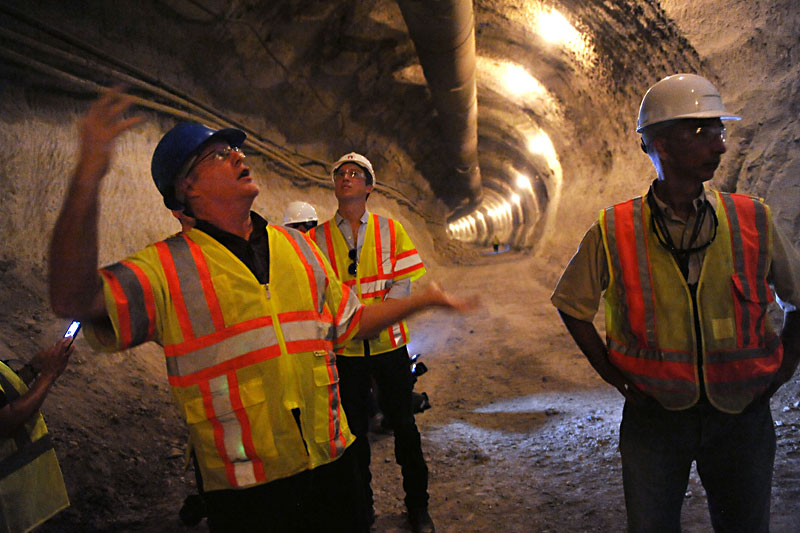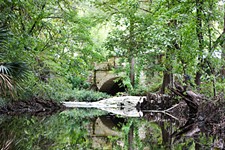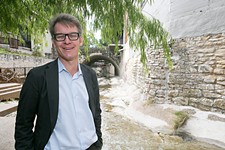Waller Creek Comes to Life
Conservancy seeks radical makeover east of Downtown
By Robyn Ross, Fri., Nov. 13, 2015
The cold came on with the setting sun, sinking into Waller Creek and seeping into coats, hats, and the fingertips of seldom-used gloves. It reddened cheeks and numbed noses. But it didn't stop the throngs of Austinites from descending to the concrete path along the creek, where the normally dark limestone walls were bathed in brilliant light. Cords of blue electroluminescent wire inside the Seventh Street tunnel marked the height of the 100-year floodline. Columns of glowing, white LED tubes stood atop poles planted in the water, leading around a bend in the creek.
Despite the arrival of sub-freezing temperatures, an estimated 2-3,000 people attended "Light Night," the inaugural "Creek Show," last November. The second annual "Creek Show," produced by the Waller Creek Conservancy, opens tonight, Nov. 12, and runs for 10 days. (See "Illuminating Waller Creek," Nov. 13) Like its predecessor, this year's event invites the public to experience the Waller Creek of the future: a popular public space that's safe, clean, and inspiring.
"Last year we found that people said, 'Wow, they opened this area for tonight!'" says "Creek Show" director Ingrid Spencer, a volunteer. "And we were like, 'Actually, this area's always here – nobody opened it, it's just that its potential is not being used.'"
But changes are under way in Waller Creek that will engage that potential, leading to a radical makeover of the east side of Downtown. The flood-control tunnel that will lift 28 acres out of the floodplain is partially complete and is already circulating water through the creek. The stagnant drainage ditch that Waller Creek once was has been replaced by a deeper, flowing, healthier stream.
And along that creek, over the next 10 years, a 1.5-mile linear park will be built, running from Waterloo Park to Lady Bird Lake. For more than a year, the landscape architects and designers of New York-based Michael Van Valkenburgh Associates, Inc. and city staff have been drafting a framework to transform land along the neglected waterway into an accessible and inviting trail system. The Waller Creek Conservancy, one of Austin's biggest public-private partnerships, is devising a strategy to fund those plans. If all goes according to schedule, Waterloo Park, the group's first project, will reopen in 2018.
What sets this creek improvement apart from past stalled efforts is the flood-control tunnel system, a massive public infrastructure project that will be completed in the next 18 months. With that protection in place, the conservancy can move forward on its plans to build world-class parks – if it can engage the hearts and wallets of philanthropists, developers, and the general public.
"We have the opportunity right now to do this because of what's happening in Austin," says Peter Mullan, the conservancy's CEO. "The tunnel is being done, the economy's really robust, we know development is coming, which means people are coming here, so there is going to be demand. We're in a good critical moment to get this thing done and make something really terrific happen."
The Green Spine
Let's get this out of the way: Waller Creek is not "Austin's Riverwalk." While it is a recirculated waterway flanked by public spaces, those spaces will not be a continuous succession of restaurants and bars. There will be no barges cruising the stream. Most importantly, the Waller Creek project isn't a concrete-lined channel, but fundamentally a restoration of a natural stream environment – albeit a restoration that's made possible through mechanical interventions.
What the project will be – in a decade or so – is a new pedestrian- and bicycle-oriented connection between the University of Texas and Lady Bird Lake. Mullan calls it a "green spine" that will knit together neighborhoods – the Red River music district, Palm Park, the Rainey Street district – that are currently hard to walk between. New paths at both the street and creek levels will be aligned to promote safety, with stairs or ramps for access planned at every block.
Along the way, the trail will link new – or revitalized – parks with landscapes and activities inspired by their surroundings. Waterloo Park, the northernmost part of the project, will be remade with a large lawn Mullan calls the "living room of the city" and an ambitious new performance venue accommodating 7,000 spectators. Design work on the park, closed since 2011 for construction of the flood-control tunnel's main inlet, began in September.
South of Waterloo, a creek-level park will be built near Eighth Street, partly on land reclaimed from the pending relocation of the Austin Police Department's headquarters. The creek then passes through a narrower, more urbanized channel between Seventh and Fourth streets – the area where "Creek Show" occurs – before emerging into Palm Park, which will eventually transform into a family-oriented greenspace with additional trees and playgrounds. From there the trail will wind past the Convention Center and under Cesar Chavez to a wilder, more natural section, where suspension bridges transport pedestrians 35 feet above the water, before joining the Butler Trail on Lady Bird Lake, just east of the Waller Creek Boathouse. The price tag for the whole park and trail project is estimated at $220 million.
The Waller Creek Tunnel
None of this would be possible without the flood-control tunnel, currently under construction Downtown. Buried 50 to 70 feet below ground, the tunnel stretches from an inlet structure in Waterloo Park to an outlet below the surface of Lady Bird Lake, between the creek mouth and boathouse. In heavy rains, which have historically inundated and eroded the creek, the tunnel will capture the majority of stormwater and divert it to the lake. The main inlet, still under construction in Waterloo Park, will capture water surging into Downtown from upstream, and additional inlets near Fourth and Eighth streets will take runoff from the area between the park and Fourth Street. In flash floods, the creek will still rise, but only about four or five feet. During the May and October floods this year, the tunnel and outlet diverted some stormwater, though the three inlets and their debris-collection and -removal systems were not finished, so the system as a whole was not fully functional. At capacity, the tunnel will carry 3.7 million gallons of water a minute, roughly the equivalent of five Barton Springs Pools. "You're talking about diverting essentially a small river under Downtown," says Joe Pantalion, acting director of the city's Watershed Protection Department.
Because the tunnel removes the threat of damage from major floods, previously neglected areas of eastern Downtown can be developed (however, the tunnel won't prevent flooding north of 12th Street). Sites that fall in the 100-year floodplain, which is up to 800 feet wide, heretofore have been unable to secure building permits, investors, or insurance due to their location. All that is about to change. In fact, the city is counting on new development and increased density in the 28 acres newly lifted out of the floodplain to pay for the tunnel project (see "Paying for Waller Creek," Nov. 13).
But the tunnel also plays a crucial role outside of flood events. Because the tunnel is lower than Lady Bird Lake, it always holds water, but in dry weather, the direction of the flow is reversed. Since their activation in June, circulation pumps have drawn water through the tunnel and up into the main Waterloo Park inlet, where it cascades through a series of "ladders" to increase the amount of dissolved oxygen in the water – essential for aquatic life – before being released into the creek. The result is a creek that, outside of floods, always has a healthy and predictable flow – simulating the ideal conditions of a natural environment.
A pipe connects the pond above the inlet structure to the creek below, allowing water, insects, fish, and organic material like leaves to pass through. Smaller systems with a similar purpose are in place at the Fourth and Eighth street inlets, where dams that channel water into the inlets would pose an obstacle for fish, turtles, and aquatic insects trying to navigate the stream. Watershed Protection engineers developed "eco-weirs," a type of fish ladder, made of stacked rocks on the downstream side of the dams. These form a path over the dam at an angle wildlife can manage.
"As this tunnel was being designed, we were trying to do it in the most environmentally sensitive manner possible, to maintain the natural function of the creek," Pantalion says. "It's difficult to do in the middle of downtown in a city, but our goal is to make Waller Creek really resemble a natural Hill Country stream."
It's a blend of the natural and mechanical that Michael Van Valkenburgh Associates principal Gullivar Shepard says is increasingly common as cities around the world reconsider their relationship with nature. "We have to have a complementary and productive relationship," he says, "as opposed to being hands-off or being detrimental [to nature], like cutting it down. It's an idea that's just evolving out of need. We need the presence of nature in cities, and we need it to be healthy, in terms of environmental benefits and social benefits."
Where the Roots Are
Despite the brilliance of this October day, Palm Park is deserted. Traffic chugs along I-35, on the park's eastern border, and construction on the nearby Fairmont Austin hotel fills the air with the clamor of heavy equipment. Viewed from the Third Street bridge, the banks of Waller Creek are a mess: One has been coated with concrete, the other gnawed by erosion until tree roots are exposed like shoddy wiring. But the water in the creek is flowing and clear, and near the stream's edge a solitary fish guards a white, pebbly circle a foot in diameter.
"That's a bluegill nest," Shepard points out. "Its young will be spawned out of that."
Shepard and Mullan are winding their way from the Hilton Garden Inn on Fifth Street – where the water passes through a concrete channel bordered with buildings – to the creek mouth on Lady Bird Lake, where the heavy foliage makes it feel like a hidden jungle. It's a study in contrasts, and a journey Shepard's team has made many times in the past year to document the nuances of the landscape.
The traditional approach to designing a park and trail system – using a computer program to roughly map the existing conditions, and then start drawing the new plan – doesn't work for Waller Creek. "This was so spatial and complicated, it only really worked to put on waders, get down in there and look for, say, 'How can we get a path here, and not disturb that tree, and have good sight lines so you'd feel safe?'" Shepard says. "A landscape architecture drawing shows a tree as a circle, but we know a tree isn't actually a circle – so you have to get under the tree and understand where the roots are."
Shepard and the Michael Van Valkenburgh Associates team, which includes engineers, hydrologists, and biologists from the Lady Bird Johnson Wildflower Center, as well as landscape architects, studied the creek foot-by-foot, wearing GPS antennae on their hats to map the ground they'd covered and using drones to take photos. They often were joined by city staff from the Watershed and Public Works departments, particularly when working on areas where the tunnel and surface improvements connect. For instance, as the inlets at Fourth and Eighth streets are completed, the teams are in dialogue about an alignment for the bike and pedestrian paths that won't conflict with tunnel function.
The product of this partnership is the just-completed Creek Corridor Framework, which lays out the future location of those paths. In some places the trail will move from its current location to the opposite bank, to create better sight lines or to help with erosion control. In others, a ground-level path will parallel the creek-level path, creating a phenomenon Shepard calls an "activity bridge," in which people on the two paths see one another and reinforce one another's security and sense of belonging. It's a major upgrade to the disconnected, often hidden path listed on the Parks & Rec Department's trail directory as the 1.6-mile Waller Creek Greenbelt. Some sections of the path have been broken, with some erosion measures washed away by the very water they were meant to control.
A Lasting Transformation
That infrastructure is what remains of past efforts to remake the creek. In fact, the idea of transforming Waller Creek has been proposed roughly once a decade since the Seventies, when cities honored the country's bicentennial by offering a "gift" to the nation. Austin's gift was a citizen-devised "bold plan to preserve, restore, and enhance" its creeks. The plan included greenbelt trails along 18 creeks, but four received attention in time for the bicentennial: Shoal Creek, Boggy Creek, Blunn Creek, and Waller Creek shared $1 million in trail improvements. By the late Seventies, several million dollars of additional funding had been approved for Waller Creek, and Waterloo Park and Symphony Square had been built.
But no makeover of the creekside trails would survive if a flood could wash away landscaping and benches. And the flood-control tunnel, supported by voters in a 1998 bond election, languished as it became clear costs were much higher than the $25 million voters authorized. The project stalled until then-Council Members Sheryl Cole and Betty Dunkerley revived it with the proposal to establish a tax increment financing (TIF) reinvestment zone to fund the tunnel's construction. Cole also appointed the Waller Creek Citizen Advisory Committee to identify priorities for the creek, which are described in the master plan adopted by City Council in 2010. Mullan and Shepard say that group's decision to create a system of parks and trails, bordered by increased density, laid the foundation for today's plan.
The same year, Cole and then-Council Member Randi Shade initiated the formation of a nonprofit to steward the ground-level improvements. Based on other cities' experience, it became clear to Cole that Waller Creek needed a private partner. "The idea that we were going to have to have private philanthropy make the above-ground improvements happen was clear from the beginning," she says.
Cole tapped Melba Whatley, who had served as chair of the Facilities Committee at St. Edward's University, to lead the group. "At the time I didn't know where Waller Creek was," Whatley remembers. "I was sitting in this office [three blocks from the creek], but I only had some vague idea there was a little creek over there, and I had never been to City Hall." Whatley was later joined by civic leaders Melanie Barnes and Tom Meredith, and together they formed the Waller Creek Conservancy and began looking for additional board members.
Park conservancies, a relatively new arrival to Austin, are nonprofit organizations, typically with a full-time staff, that devote their efforts to a particular amenity or green space. (In Austin, conservancies have organized to support Pease Park, Shoal Creek, and Barton Springs.) As work on the tunnel project is completed, the Waller Creek Conservancy will assume responsibility for the creek corridor, in conjunction with the Parks and Watershed departments. The conservancy will raise funds, run programs, and maintain the trail system, including Waterloo and Palm parks, though the land will remain owned by the city of Austin. Along with the city, the conservancy will negotiate with private landowners along the creek to allow the continuity of the trail on their land, through deed or easement – a process similar to the development of the Lady Bird Lake boardwalk.
Any money raised at the parks – such as ticket revenue at a concert – can be reinvested in the district by the conservancy. That's something the Parks department can't do, says Parks Assistant Director Marty Stump, one of several city staff involved with the Waller Creek partnership. "The city has more than 250 parks and hundreds of thousands of acres, and we don't have the ability to focus more attention on one body of parkland than we can apply to other parkland," he says. "But a conservancy has the ability to be very targeted."
In fall 2011 the conservancy launched an international competition to select the park system's designer. An independent jury named the team of Michael Van Valkenburgh Associates, Inc. and Thomas Phifer & Partners the winner in fall 2012.
Stephanie McDonald, Cole's former policy aide who had helped research the project, served as the conservancy's first executive director. In February 2015, the conservancy hired Mullan, formerly the executive vice president of the High Line in New York City. That linear park, built on an old elevated rail line roughly the same length as the Waller Creek project, attracted 6 million visitors last year. It's estimated to have enticed $2 billion of new economic activity to the area. Between 2003, when the High Line was in planning stages, and 2011, when two of its three sections were complete, nearby land values increased by 103%.
The funding strategy for Waller Creek's nearly $150 million flood-control tunnel relies on a similar increase in value on the east side of Downtown. The parks will link together new and denser developments, many of which are already in the planning stages. That construction won't displace an existing neighborhood – there isn't one, because of the flood risk – but it will have ripple effects. The homeless, the primary users of today's park, will likely feel them first.
That's not a reason to refrain from developing the creek, says Ann Howard, executive director of ECHO (the Ending Community Homelessness Coalition); it's a sign that Austin needs more resources for people with barriers to housing. "We need to recognize that we've allowed Waller Creek to be home to people, and that's really not the Austin we want to live in," she says. "While the city and philanthropists are thinking about the park, let's think of some other good that can come out of this. Let's connect donors to nonprofits that are building or supporting housing, so that the people displaced by the park system have alternative and better places to live."
Rising property values may also reshape the Red River music district. Jennifer Houlihan, executive director of Austin Music People, says she's heard club managers in the corridor worry that their building will be sold or torn down, or that rents will skyrocket. "And none of that's misplaced," she says. "But we've been gratified to have a seat at the table and to be able to talk about the legacy of that street."
The conservancy and AMP have kept communication lines open since the design competition was under way, when conservancy staff brought some members of the design teams on a nighttime stroll on Red River. "We can't stop progress, and we can't stop change," Houlihan says, "but we can make sure that music is at the table when those changes are being discussed."
A Glimpse of the Future
Major progress has to wait for the tunnel's completion. Public Works division manager Roxanne Cook, who oversees the project, estimates that the tunnel system construction will be complete by late 2016 to early 2017. She says weather-related delays have pushed completion back from the original 2014 finish date; floods during construction cause delays of several weeks each. The Fourth and Eighth street inlets are still under construction, as is the inlet structure in Waterloo Park. That project hit a snag when city staff realized last spring that its original design – which was partially built – would interfere with a Capitol view corridor. The facility has been redesigned, and construction on the shorter building is expected to be completed in spring 2016. The city, the engineering firm, and the construction contractor are involved in legal negotiations over the increased construction costs.
But the design phase of the Waterloo Park and creek mouth sections of the project kicked off in September. The conservancy has initiated a capital campaign so it can start moving dirt once the city finishes the inlet. And this week's "Creek Show" gives the public a glimpse of the district's future.
"Last year a lot of people had never been down there before, and some people thought our project was complete," says the conservancy's director of programming, Meredith Bossin, with a wry smile. "That's because the creek was well lit, accessible, and smelling better. There were tons of other people of all ages around. Even if it was just three blocks, people could walk them without having to deal with street-level traffic and risky intersections.
"These are all elements of the future of Waller Creek that you get to experience in advance."
Got something to say on the subject? Send a letter to the editor.













